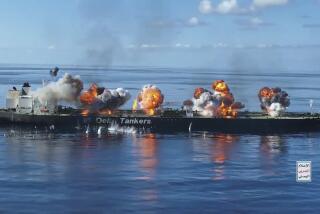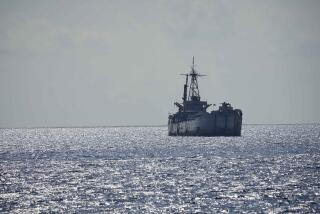U.S. destroyer joins pursuit of pirates off Somalia coast
- Share via
NAIROBI, KENYA — A U.S. destroyer and a Russian warship headed Saturday for a possible confrontation with pirates who hijacked a cargo ship carrying battle tanks, machine guns and a crew of 21.
Though pursued by ships from two of the world’s biggest naval powers, the pirates showed no sign of surrendering the Ukrainian vessel Faina, which they boarded Thursday off the Somali coast as it headed to Kenya. Instead, according to unconfirmed reports, they were demanding a $35-million ransom to turn over their unconventional booty, which includes 33 Russian-built T-72 tanks.
The pirates also warned against any raids by the U.S. or Russian navies.
The brazen seizure occurred in notoriously dangerous international waters off the Horn of Africa, where pirates exploit Somalia’s lawlessness. A Greek oil tanker was also seized by pirates in the area Friday, maritime officials said. And twice this year, French commandos have intervened to rescue citizens taken hostage off Somalia.
Pirates operate with relative freedom and impunity in and around the Somali port city of Eyl in the semiautonomous Puntland region, where officials say more than 300 hostages are being held and several hijacked ships are docked.
“These pirates are well-armed groups with rocket-propelled grenades and automatic weapons,” said Bile Mohamoud Qabowsade, a Puntland government advisor. “Even superpower governments have been unable to chase away the pirates. What do you think a feeble, semiautonomous Puntland government can do?”
The unusual nature of the Faina’s cargo has put greater scrutiny on the rampant piracy in the region. The international community has only recently begun to respond to the threat to commercial and recreational vessels plying these waters. Even naval ships bristling with sophisticated weaponry may not be immune from attack. This month, the U.S. Navy said one of its ships apparently was fired upon by pirates.
Since the collapse of the Somali government in 1991, the country has suffered through civil war, clan divisions, famine and, most recently, an Islamist insurgency. The United Nations abandoned its mission there in 1993 after the downing of a U.S. helicopter led to the deaths of 18 U.S. soldiers. But for the most part, the country’s troubles have been confined to its borders.
The pirate attacks in the Gulf of Aden and Indian Ocean are pushing Somalia’s problems onto the global stage.
“This piracy is starting to draw international attention,” said Abdisaid Muse Ali, a security expert and former Somalia government official. “The latest attack was a real shock.”
U.S. Navy officers agree.
“The long-term solution is going to take international cooperation,” said U.S. Cmdr. Jane Campbell, spokeswoman of the Bahrain-based 5th Fleet, which oversees the Somali coast.
During the summer, the U.N. Security Council passed a resolution to allow foreign ships in Somalia’s territorial waters to combat piracy. The U.N. may take additional measures to curtail the banditry and European nations are considering establishing a new naval mission for the region.
Last month, the U.S., Denmark and other nations formed an international coalition to patrol the waters off Somalia. During that month, officials said, the Maritime Security Patrol fended off about a dozen attempted attacks.
Officials in Somalia said they welcomed international assistance, though it was slow in coming. Fledgling governments in Mogadishu, the Somali capital, and Puntland say they are ill-equipped to handle the attacks themselves.
Experts say the best long-term solution is establishing and supporting a strong central government. Puntland officials also are calling for foreign warships to permanently patrol the coast and for the international community to provide training and equipment to help establish a Somali navy .
But U.S. officials said international naval patrols wouldn’t be enough to secure the 2,000-mile coastline.
Shipping companies and merchant marines must act more responsibly and aggressively to protect themselves, officials said. Despite the risks in the region, few vessels travel with security and many neglect to employ simple evasive techniques, such as changing course, altering speeds and assigning 24-hour lookouts, Campbell said.
“Many of these companies have chosen to just pay the ransom versus taking upfront measures to improve security,” she said.
Some asked why the Ukrainian vessel, loaded with weapons and delivering goods as part of a government-to-government transaction, traveled through some of the world’s most-dangerous waters without any security. The arms were intended for Kenya.
Officials dismissed reports about the ransom demand and said the government would not negotiate with pirates.
But experts say a payment is the likeliest outcome because a raid would endanger hostages. Ransom payments in the region are expected to top $50 million this year, one industry newsletter said.
Pirate attacks have tripled in the last three years. On average this year, three ships have been hijacked off Somalia every month.
Though it appears that hijackers of the Ukrainian vessel were unaware of its cargo, the floating cache of weapons has raised fears that the weaponry could fall into the hands of insurgents or criminals.
“These weapons are very dangerous and could have a negative impact on all of Somalia,” Qabowsade said.
--
Special correspondent Lutfi Sheriff Mohammed contributed to this report.
More to Read
Sign up for Essential California
The most important California stories and recommendations in your inbox every morning.
You may occasionally receive promotional content from the Los Angeles Times.










